If you’re playing our new Microbe Trumps game you might be interested to know that our understanding of microbes and how they interact with humans is constantly changing. But we worked closely with many microbiologists (scientists that study microbes) in our university to ensure all the details are correct.
In this game we added a category called ‘Mortality Score’. This score represents how dangerous the microbe is – many microbes aren’t dangerous at all, and in fact some make our lives a lot safer or a lot tastier!
- 0: Non-infectious or extremely low mortality.
- 1–2: Low to moderately contagious with low mortality.
- 3–4: High mortality in certain populations or conditions.
- 5: Highly infectious with a high mortality rate.
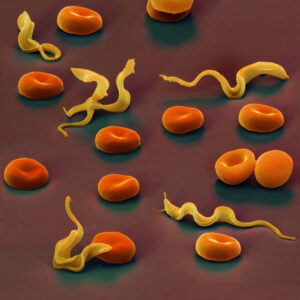
Trypanosoma brucei
Here you can see a scanning electron micrograph (SEM) of Trypanosoma alongside some red blood cells. The World Health Organization consider this a ‘Neglected Tropical Disease’ it has a high mortality rate if untreated.
Toxoplasma Gondii
Causes a condition called Toxoplasmosis. The disease is severe in immunocompromised patients (patients whose immune systems are weakened) but has a low mortality in healthy individuals.
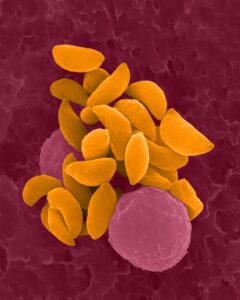

Streptococcus pyogenes
Streptococcus pyogenes is a Group A Streptococcus and is generally sensitive to penicillin but can cause severe infections like necrotizing fasciitis. Streptococcus pyogenes causes moderate mortality rates.
Streptococcus pneumoniae
Streptococcus pneumoniae is one of the causes of pneumonia. Penicillin resistance has been documented, but there are still viable treatments which include cephalosporins. Can be fatal in vulnerable populations.
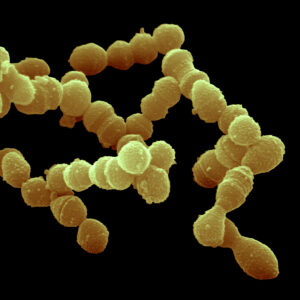
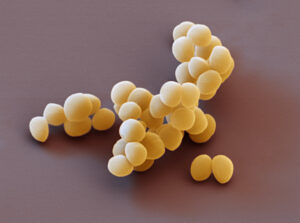
Staphylococcus aureus
One of the strains of Staphylococcus aureus is resistant to an antibiotic called methicillin, and is called MRSA (methicillin resistant Staphylococcus aureus). The resistant strains limit treatment options, but viable treatments can still include vancomycin. Staphylococcus aureus and MRSA can cause severe infections so we scored it with moderate mortality.
Shigella spp.
Here you can see Shigella bacteria, the small rods, trapped inside neutrophil cells, the most common white blood cells in humans. An increasing amount of antibiotic resistance has been noticed in medical cases. Shigella can cause severe disease, especially in children.
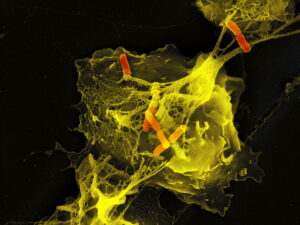

Salmonella typhi
This bacterium is one of the causes of typhoid fever. Increasing antibiotic resistance in medical cases has been noticed. Viable treatments include ciprofloxacin. Can cause severe disease, especially in children.
Saccharomyces cerevisiae
This type of yeast is non-pathogenic and used in fermentation and as a probiotic. It is considered a friendly fungi.
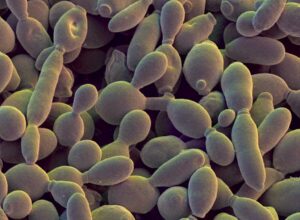

Pseudomonas aeruginosa
Resistant to many antibiotics. This can have high mortality in severe infections.
Plasmodium spp.
Coloured scanning electron micrograph (SEM) of red blood cells and Plasmodium falciparum protozoa. These protozoa (yellow) cause malaria, which is considered by the World Health Organization to be a neglected tropical disease. Multiple anti-malarials are available, but growing resistance is an issue. P. falciparum has high mortality rates.
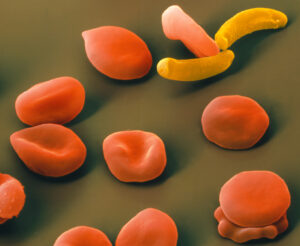
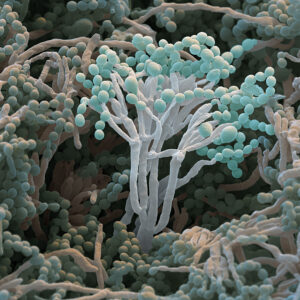
Penicillium spp.
Here you can see a coloured scanning electron micrograph (SEM) of Penicillium. The fungus is made up of fungal threads (hyphae, grey) with conidiophores (fruiting bodies, teal) at the tip. The conidiophores are made up of chains of conidia (spores), which are dispersed on the wind. Penicillium is rarely pathogenic, but when infections occur, antifungals are effective. It has a low mortality.
Non-typhoidal Salmonella
Many infections are self-limiting, which mean they resolve themselves without the need of medical intervention. Antibiotics are used in severe cases but there is a low mortality in healthy individuals.
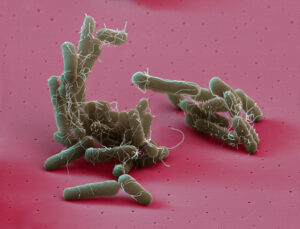

Mycobacterium tuberculosis
A coloured scanning electron micrograph (SEM) of drug-resistant Mycobacterium tuberculosis bacteria. This causes tuberculosis, a globally significant disease. Treatment requires many months of multidrug therapy. Resistance to antibacterial treatments is a big issue. Mycobacterium tuberculosis has high mortality if untreated and infections can spread out of the lungs to other organs, including the central nervous system.
Mycobacterium leprae
Mycobacterium leprae causes the disease Leprosy. Similar to Mycobacterium tuberculosis it can be treated with multidrug therapy. Mycobacterium leprae generally has a low mortality and is considered a neglected tropical disease by the World Health Organization.

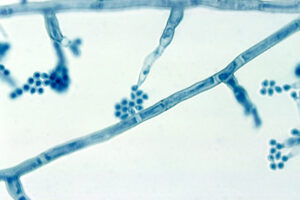
Madurella mycetomatis
This is a light micrograph of the fungus Madurella mycetomatis showing conidiophores (branches with terminal clusters of ovals) and septate hyphae (one diagonally across centre). Hyphae are the branching, filamentous structures of a fungus, that in this species are separated by septa (walls) into cellular compartments. Conidiophores are specialised hyphae that produce asexual spores (reproductive cells, ovals) called conidia. M. mycetomatis can cause an infection of the subcutaneous tissue (deepest layer of skin) known as mycetoma. While there are limited treatments, which often requires surgery, this primarily results in a chronic disease with low mortality.
Mucorales
This fungus can cause an infection called mucormycosis, which has a high mortality, especially in diabetics and immunocompromised patients (patients with weakened immune systems).
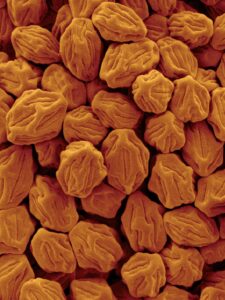
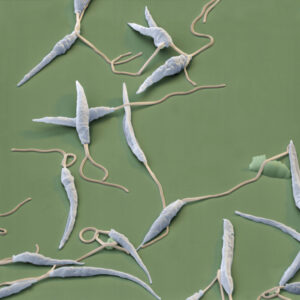
Leishmania
Can cause visceral leishmaniasis, which is the most severe form of leishmaniasis, and can easily be fatal if untreated. Leishmania is considered a neglected tropical disease by the World Health Organization.
Lactobacillus acidophilus
Lactobacillus acidophilus is generally benign and considered a friendly bacteria.
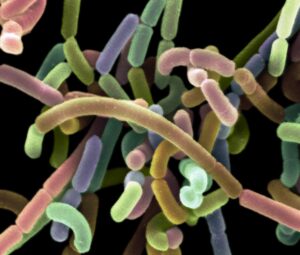
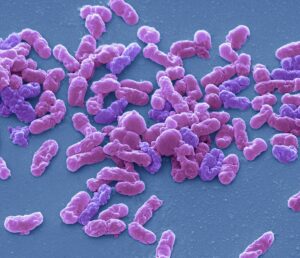
Haemophilus influenzae
While Haemophilus influenzae can cause serious infections in children, several antibiotics are effective and vaccination has further reduced incidence.
Giardia
Generally has a low mortality. It is a common cause of waterborne disease.
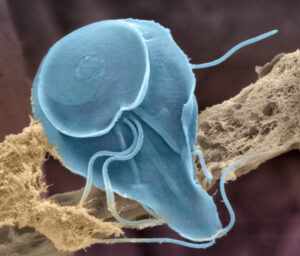
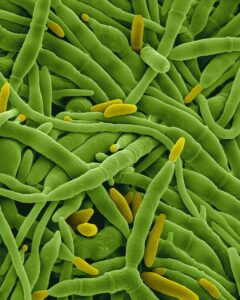
Fusarium spp.
Fusarium can be resistant to many antifungals which limits medical treatment options. It has high mortality in invasive infections.
Escherichia coli
Escherichia coli is a common gut flora but some pathogenic strains exist. Many antibiotics are effective and there is low mortality in most cases.

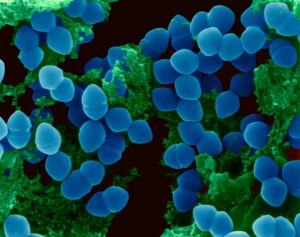
Enterococcus faecium
Infections are often resistant to treatment. It is associated with hospital infections and has moderate mortality.
Entamoeba histolytica
Can cause severe disease but mortality varies.
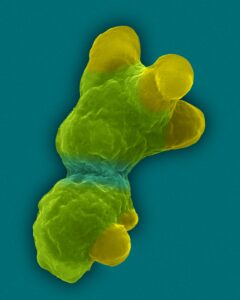

Cryptosporidium spp.
There are limited treatments and the infections are severe in immunocompromised patients (patients with weakened immune systems). Overall it has moderate mortality and is considered a neglected tropical disease by the World Health Organization.
Cryptococcus neoformans
Has a very high mortality rate in immunocompromised patients (patients with weakened immune systems).


Candida parapsilosis
It is sensitive to several antifungals and has a lower mortality compared to C. auris.
Candida auris
Multidrug-resistant and limited treatments are available. Can have high mortality rates.
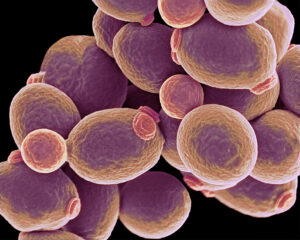

Candida albicans
While there are treatments available, it can be very serious in immunocompromised individuals (patients with weakened immune systems).
Babesia spp.
Here you can see Babesia sporozoites, the infectious stage, alongside an infected red blood cell. They enter an red blood cells to undergo asexual reproduction and the offspring burst the cell. There are viable treatments available, but Babesia can be severe in immunocompromised individuals (individuals with weakened immune systems). Overall it has moderate mortality.
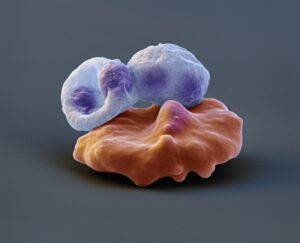
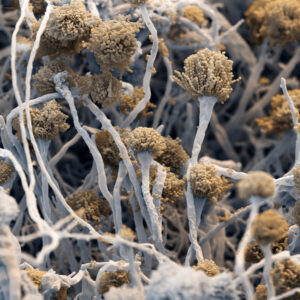
Aspergillus fumigatus
The fungus is made up of fungal threads (hyphae, grey) with conidiophores (fruiting bodies, brown) at the tip. The conidiophores are made up of chains of conidia (spores), which are dispersed on the wind. Inhalation of spores by people with a weakened respiratory system, for example asthmatics or those with cystic fibrosis, leads to an allergic reaction known as aspergillosis. A. fumigatus usually grows on decomposing organic matter. Has a high mortality in immunocompromised patients (patients with weakened immune systems) if the aspergillosis becomes invasive.
Acinetobacter baumannii
Multidrug-resistant which results in limited available medical treatments. Has a high mortality rate.

